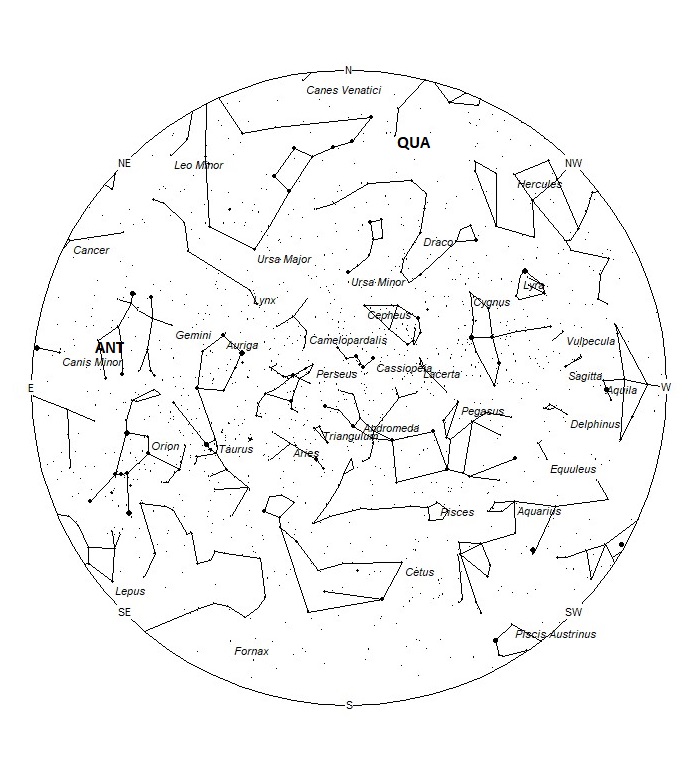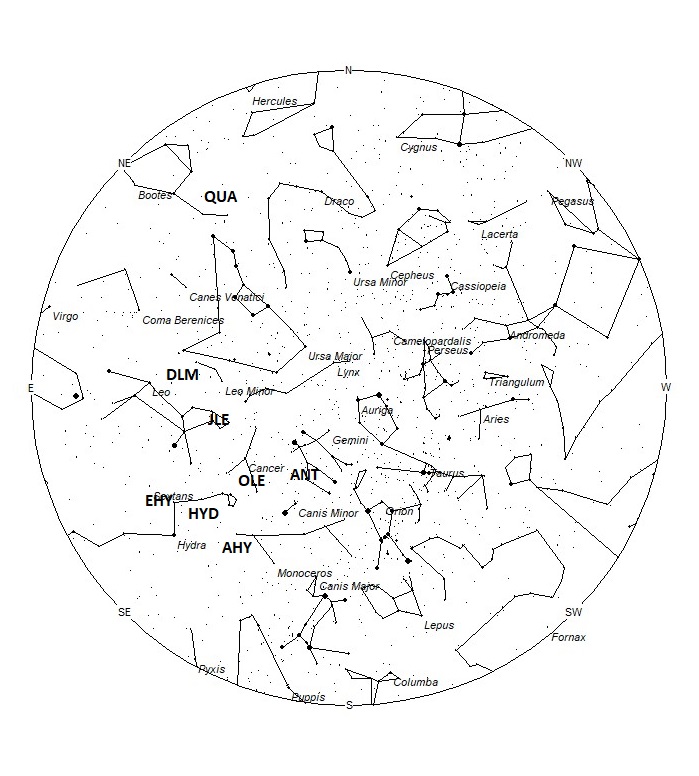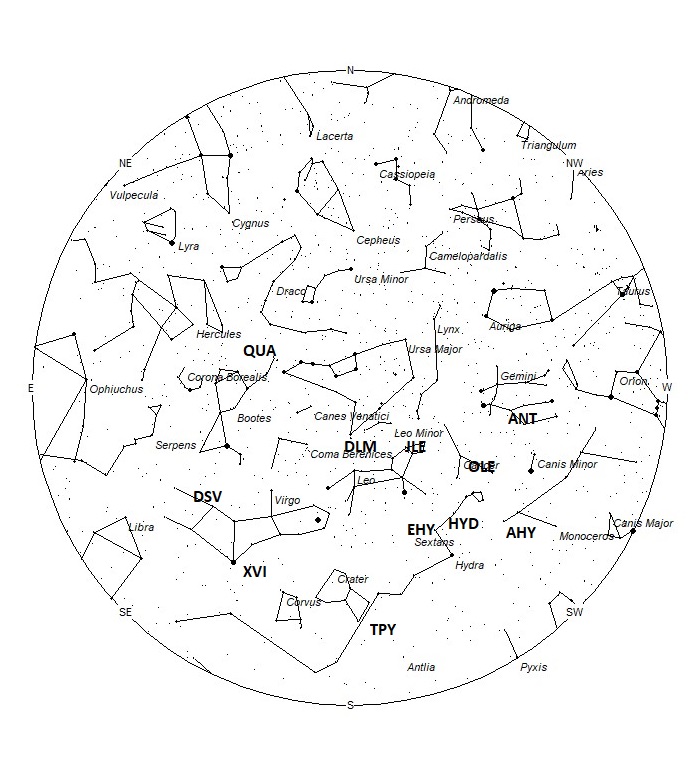During this period, the moon reaches its last quarter phase on Monday December 27th. At that time the moon lies 90 degrees west of the sun and rises near midnight local standard time (LST). As the week progresses the waning crescent moon will rise approximately 45 minutes later each night, allowing more of the morning hours to be free of interfering moonlight. The estimated total hourly meteor rates for evening observers this week is near 3 as seen from mid-northern latitudes (45N) and 2 as seen from tropical southern locations (25S). For morning observers, the estimated total hourly rates should be near 11 as seen from mid-northern latitudes (45N) and 9 as seen from tropical southern locations (25S). The actual rates will also depend on factors such as personal light and motion perception, local weather conditions, alertness, and experience in watching meteor activity. Morning rates are reduced during this period due to interfering moonlight. Note that the hourly rates listed below are estimates as viewed from dark sky sites away from urban light sources. Observers viewing from urban areas will see less activity as only the brighter meteors will be visible from such locations.
The radiant (the area of the sky where meteors appear to shoot from) positions and rates listed below are exact for Saturday night/Sunday morning December 25/26. These positions do not change greatly day to day so the listed coordinates may be used during this entire period. Most star atlases (available at science stores and planetariums) will provide maps with grid lines of the celestial coordinates so that you may find out exactly where these positions are located in the sky. I have also included charts of the sky that display the radiant positions for evening, midnight, and morning. The center of each chart is the sky directly overhead at the appropriate hour. These charts are oriented for facing south but can be used for any direction by rotating the charts to the desired direction. A planisphere or computer planetarium program is also useful in showing the sky at any time of night on any date of the year. Activity from each radiant is best seen when it is positioned highest in the sky, either due north or south along the meridian, depending on your latitude. It must be remembered that meteor activity is rarely seen at the radiant position. Rather they shoot outwards from the radiant, so it is best to center your field of view so that the radiant lies at the edge and not the center. Viewing there will allow you to easily trace the path of each meteor back to the radiant (if it is a shower member) or in another direction if it is sporadic. Meteor activity is not seen from radiants that are located far below the horizon. The positions below are listed in a west to east manner in order of right ascension (celestial longitude). The positions listed first are located further west therefore are accessible earlier in the night while those listed further down the list rise later in the night.
These sources of meteoric activity are expected to be active this week.
Now that the activity from particles produced by comet 2P/Encke have ceased encountering the Earth, the Taurid showers for 2021 are over and we resume reporting activity from the Anthelion (ANT) radiant. This is not a true radiant but rather activity caused by the Earth’s motion through space. As the Earth revolves around the sun it encounters particles orbiting in a pro-grade motion that are approaching their perihelion point. They all appear to be radiating from an area near the opposition point of the sun, hence the name Anthelion. These were once recorded as separate showers throughout the year, but it is now suggested to bin them into a category separate from true showers and sporadics. This radiant is a very large oval some thirty degrees wide by fifteen degrees high. Activity from this radiant can appear from more than one constellation. The position listed here is for the center of the radiant which is currently located at 07:08 (107) +22. This position lies in central Gemini, 2 degrees northwest of the 4th magnitude star known as Wasat (delta Geminorum). This radiant is best placed near 01:00 local standard time (LST) when it lies on the meridian and is highest in the sky. Rates at this time should be near 2 per hour as seen from the northern hemisphere and 1 per hour as seen from south of the equator. With an entry velocity of 30 km/sec., the average Anthelion meteor would be of slow velocity.
The Volantids (VOL) are a weak shower active from December 27 through January 4. They are best known for outbursts of activity near the new year. On December 31st, the radiant is located at 08:02 (121) -72. This position lies in central Volans, 4 degrees south of the 4th magnitude star known as epsilon Volantis. These meteors are not visible north of 20 N latitude. At 28 km/sec. the Volantids produce meteors of medium-slow velocity. Expected rates this week are less than 1 per hour no matter your location.
The alpha Hydrids (AHY) were discovered by Dr. Peter Brown and are mentioned in his article “A meteoroid stream survey using the Canadian Meteor Orbit Radar”. This shower is active from December 15 through January 22 with maximum activity occurring on January 5th. The radiant is currently located at 08:06 (121) -07. This position lies in eastern Monoceros, 4 degrees south of the 4th magnitude star known as zeta Monocerotis. These meteors are best seen near 0200 LST when the radiant lies highest above the horizon. At 45 km/sec. the alpha Hydrids produce meteors of medium velocity. Expected rates this week are less than 1 per hour no matter your location.
The Omicron Leonids (OLE) were also discovered by Damir Šegon and the Croatian Meteor Network team based on studying SonotaCo and CMN observations (SonotaCo 2007-2011, CMN 2007-2010). These meteors are active from December 20 through January 22. Maximum activity occurs on January 9th. The radiant is currently located at 08:18 (125) +11. This position lies in southern Cancer, 2 degrees northeast of the 4th magnitude star known as Tarf (beta Cancri). These meteors are best seen near 0200 LST when the radiant lies highest above the horizon. At 39 km/sec. the omicron Leonids produce meteors of medium velocity. Expected rates this week are less than 1 per hour no matter your location.
The C Velids (CVE) is a continuation of the Puppid/Velid activity this time of year. Unlike the two-week activity during the first half of December, the C Velids are only active on 6 nights centered on December 28th. This segment of the Puppid/Velids is not as strong as the previous one and rates are low, even at maximum activity. At maximum, the radiant is located at 09:20 (140) -54. This area of the sky lies in southern Vela, 2 degrees north of the 2nd magnitude star known as Markeb (kappa Velorum). These meteors are best seen near 0400 LST when the radiant lies highest above the horizon. At 39 km/sec. the C Velids produce meteors of medium velocity. Like all sources of the Puppid/Velid complex, these meteors are not well seen from the northern hemisphere. They are best seen from the deep southern hemisphere where the sources are found high in the sky during the southern summer mornings. Activity from this complex is weak in January with barely discernible radiants in Carina and Crux. Activity increases in February with several radiants spread across Centaurus. This complex weakens again in March with the last traces appearing in the Lupus/Norma region of the sky.
The sigma Hydrids (HYD) are active from a radiant located at 09:22 (141) -02. This area of the sky is located in western Hydra, 3 degrees southeast of the 4th magnitude star known as theta Hydrae. Current rates should be less than 1 per hour no matter your location. These meteors are best seen near 0300 LST, when it lies highest above the horizon in a dark sky. With an entry velocity of 57 km/sec., the average sigma Hydrid meteor would be of swift velocity.
The January Leonids (JLE) were discovered by Dr. Peter Brown and are mentioned in the same publication as the Alpha Hydrids. This shower is active from December 28 through January 07 with maximum activity occurring on January 2nd. The radiant is currently located at 09:31 (143) +26. This position lies in northwestern Leo, 2 degrees east of the 4th magnitude star known as Al Min’ħar al A’sad (kappa Leonis). These meteors are best seen near 0400 LST when the radiant lies highest above the horizon. At 52 km/sec. the January Leonids produce meteors of swift velocity. Expected rates this week are less than 1 no matter your location.
The eta Hydrids (EHY) were discovered by Damir Šegon and the Croatian Meteor Network team based on studying SonotaCo and CMN observations (SonotaCo 2007-2011, CMN 2007-2010). This radiant is active from November 26 through January 1st with maximum activity occurring on December 12th. The radiant is currently located at 09:50 (148) -01, which places it in western Hydra, 2 degrees east of the 4th magnitude star known as iota Hydrae. This position is close to that of the sigma Hydrids so care must be taken to separate the two sources. These meteors are best seen near 0300 LST when the radiant lies highest above the horizon. Current rates should be less than 1 per hour no matter your location. With an entry velocity of 61 km/sec., most activity from this radiant would be of swift speed.
The theta Pyxidids (TPY) consist of two weak showers that peak two weeks apart. The later version is now active from December 8 through January 8 with maximum occurring on December 18. The radiant is currently located at 10:51 (163) -26. This area of the sky is located in southwestern Hydra, 10 degrees south of the 3rd magnitude star known as nu Hydrae. These meteors are best seen near 0400 LST when the radiant lies highest above the horizon. Current rates are expected to be less than 1 per hour no matter your location. At 64 km/sec. the theta Pyxids would produce mostly swift meteors.
The December Leonis Minorids (DLM) are a shower of long duration active from December 1st all the way through February 10th. Maximum occurs near December 19th when rates may reach 3 an hour. During this period, I would expect hourly rates of 2 from a radiant located at 11:10 (168) +28. This position lies in northern Leo, 7 degrees north of the 3rd magnitude star known as Zosma (delta Leonis). These meteors are best seen near 0400 LST when the radiant lies highest above the horizon. At 63 km/sec. the December Leonis Minorids produce mostly swift meteors. These meteors are most commonly known as the Comae Berenicids.
The December chi Virginids (XVI) are another shower discovered in Japan by observers using data from SonotaCo. This source is active from November 26 through December 30 with maximum occurring on December 12th. The radiant is currently located at 13:18 (199) -15, which places it in southern Virgo, 4 degrees southwest of the 1st magnitude star known as Spica (alpha Virginis). Hourly rates should be less than 1 no matter your location. These meteors are best seen during the last dark hour before dawn, when the radiant lies highest above the horizon in a dark sky. At 69 km/sec. the December chi Virginids would produce mostly swift meteors.
The December sigma Virginids (DSV) is a source of long duration discovered by John Greaves using the data of SonotaCo. This source is active from November 26 through January 24 with peak rates occur near December 21st. The current radiant location is at 14:05 (211) +04 which places it in eastern Virgo, 4 degrees north of the 4th magnitude star known as tau Virginis. Current hourly rates would be less than 1 no matter your location. These meteors are best seen during the last dark hour before dawn, when the radiant lies highest above the horizon in a dark sky. At 66 km/sec. the December Sigma Virginids would produce mostly swift meteors.
The Quadrantids (QUA) are active from December 26th through January 16th. Maximum occurs on January 3rd near 20:40 Universal Time. The radiant is currently located at 14:54 (224) +50. This position lies in northern Bootes , roughly between 3rd magnitude Edasich (iota Draconis) and Nekkar (beta Boötis). 2nd magnitude Alkaid (eta Ursae Majoris), the bright star at the end of the Big Dipper’s handle, lies 15 degrees to the west. These meteors are best seen during the last hour before dawn when the radiant lies highest above the horizon in a dark sky. At 41 km/sec. the Quadrantids produce meteors of moderate velocity. These meteors are visible from the southern tropics but not seen from the deep southern hemisphere.
As seen from the mid-northern hemisphere (45N) one would expect to see approximately 8 sporadic meteors per hour during the last hour before dawn as seen from rural observing sites. Evening rates would be near 2 per hour. As seen from the tropical southern latitudes (25S), morning rates would be near 7 per hour as seen from rural observing sites and 2 per hour during the evening hours. Locations between these two extremes would see activity between the listed figures. Morning rates are reduced by moonlight during this period.
You can keep track of the activity of these meteor showers as well as those beyond the limits of visual observing by visiting the NASA Meteor Shower Portal available at: https://meteorshowers.seti.org/ You can move the sky globe to see different areas of the sky. Colored dots indicate shower meteors while white dots indicate sporadic (random) activity. The large orange disk indicates the position of the sun so little activity will be seen in that area of the sky.
| SHOWER | DATE OF MAXIMUM ACTIVITY | CELESTIAL POSITION | ENTRY VELOCITY | CULMINATION | HOURLY RATE | CLASS |
| RA (RA in Deg.) DEC | Km/Sec | Local Standard Time | North-South | |||
| Anthelions (ANT) | — | 07:08 (107) +22 | 30 | 01:00 | 2 – 1 | II |
| Volantids (VOL) | Dec 31 | 08:02 (121) -72 | 28 | 02:00 | <1 – <1 | III |
| alpha Hydrids (AHY) | Jan 05 | 08:06 (121) -07 | 45 | 02:00 | <1 – <1 | IV |
| omicron Leonids (OLE) | Jan 09 | 08:18 (125) +11 | 39 | 02:00 | <1 – <1 | IV |
| C Velids (CVE) | Dec 28 | 09:20 (140) -54 | 39 | 03:00 | <1 – 1 | IV |
| sigma Hydrids (HYD) | Dec 07 | 09:22 (141) -02 | 57 | 03:00 | <1 – <1 | II |
| January Leonids (JLE) | Jan 02 | 09:31 (143) +26 | 52 | 03:00 | <1 – <1 | II |
| eta Hydrids (EHY) | Dec 12 | 09:50 (148) -01 | 61 | 04:00 | <1 – <1 | II |
| theta Pyxidids (TPY) | Dec 01 | 10:51 (163) -26 | 64 | 05:00 | <1 – <1 | IV |
| December Leonis Minorids (DLM) | Dec 19 | 10:40 (160) +31 | 63 | 05:00 | 1 – <1 | II |
| December chi Virginids (XVI) | Dec 12 | 13:18 (199) -15 | 69 | 07:00 | <1 – <1 | IV |
| December sigma Virginids (DSV) | Dec 21 | 14:05 (211) +04 | 66 | 07:00 | <1 – <1 | IV |
| Quadrantids (QUA) | Jan 03 | 14:54 (224) +50 | 41 | 08:00 | <1 – <1 | I |





